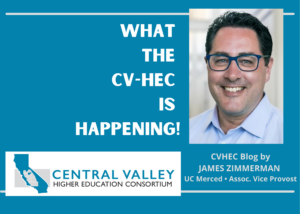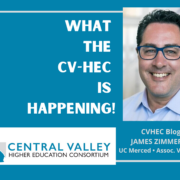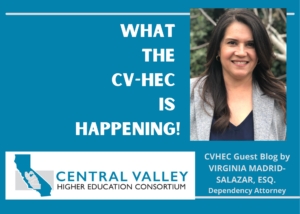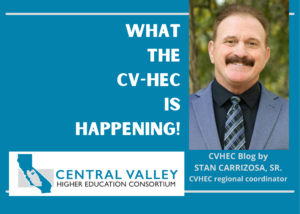CV-HEC BLOG: UC Enrollment Push Supported by CVHEC/UC Merced Transfer Project and New Mapper Software
(This issue’s “What The CV-HEC Is Happening” Blog features guest contributor Dr. James Zimmerman, senior associate vice provost and dean for Undergraduate Education at the University of California-Merced where he is also director of the Center for Engaged Teaching and Learning and a physics professor. He serves on the CVHEC/UC Merced Transfer Project committee and here he blog-connects its work the past year to a recent article on UC enrollment expansion).
The California UC Board of Regents has declared its intent to expand enrollment by adding 20,000 new seats in the next few years as outlined in a UCLA Daily Bruin article published May 12 that also presents the relevant challenges associated with this goal.
 This illuminating journalistic endeavor by higher education reporters Megan Tagami and Lisa Huiqin is timely for students in the Central Valley Higher Education Consortium’s nine-county region as member institutions UC Merced, Merced College and Bakersfield College have used the last two years to lay groundwork for a CVHEC/UC Merced Transfer Project that is designed to bring the college transfer experience into intersegmental alignment.
This illuminating journalistic endeavor by higher education reporters Megan Tagami and Lisa Huiqin is timely for students in the Central Valley Higher Education Consortium’s nine-county region as member institutions UC Merced, Merced College and Bakersfield College have used the last two years to lay groundwork for a CVHEC/UC Merced Transfer Project that is designed to bring the college transfer experience into intersegmental alignment.
With this dedicated leadership and collaboration by consortium members and professionals, the Transfer Project is now being undertaken by other members of CVHEC’s 30 institutions of higher education for valley-wide implementation in 2023. And it comes complete with a free and public-facing software strategy students can use to master the curricular pathway to a four-year degree.
Setting the Stage
The Daily Bruin article illustrates that following an extensive decades-long push in California high schools to promote college-readiness and increase the number of UC-eligible students graduating each year, we are experiencing an increased demand for access to our UC campuses throughout the state.
Even more impressive, is the number of students eligible for transfer to UC from our California Community Colleges. Not only are more transfer-eligible students coming from community colleges, but these transfers also succeed in completing their UC degrees at higher rates than all other UC students.
In particular, Tagami and Huiqin cite the targeted efforts of UC Merced to increase the number of community college students from the Central Valley that successfully transfer to UC Merced. This effort emerged in 2018 as UC Merced committed anew to recruiting/retaining local community college transfers. UC Merced officials met with a focus group of Central Valley community college chancellors/presidents in the CVHEC region to clarify and address the challenges.
Forthright TAG/ADT conversations
During this meeting, the group discussed the Transfer Admission Guarantee (TAG) project agreed to by some UC campuses as a transfer pathway for community college students to be accepted to the UC. This discussion quickly evolved into a compare and contrast of the UC-based TAG agreements and the California State University systemwide transfer pathways project called the Associate Degree for Transfer (ADT).
Completion of ADT’s as an effective pathway for transfer to the CSU far outpaced the number of successful transfers to UC through the TAG agreements. This is credited in large part to the consistency of the CSU’s commitment/acceptance of the community college ADT’s, that when completed, fulfill the lower-division requirements for guaranteed transfer to CSU.
Simply put, if a student successfully completes the ADT pathway in a particular discipline/major, they have fulfilled the lower-division requirements and are accepted as a transfer (third-year) student in good-standing to the CSU.
Walking the talk
Fast forward to today … with its Transfer Project, the Central Valley Higher Education Consortium and UC Merced have been engaged in a collaborative, intersegmental process to review and assess the community college ADT’s with the intent to accept the completion of selected ADT’s in various disciplines as fulfilling the lower-division requirements for successful transfer to UC Merced.
This process brings together community college and UC Merced faculty in common discipline/majors to review/approve existing or slightly modified ADT’s for successful transfer to UC Merced. To date, seven of the CVHEC community college members are now engaged in the approval process with five more in line to begin the approval process in fall 2022 for implementation in 2023.
The culminating feature in the project’s process is the implementation of a public-facing, internet-based software application called Program Pathways Mapper with two key outcomes for transfer student success:
- This software merges an updated/accurate list of community college courses in approved ADT/curricular pathway with the corresponding upper-division coursework at UC Merced to show a complete four-year pathway to degree completion.
- The Program Pathways Mapper software makes all of this information available through public internet access to all students, parents and community college and high school faculty and counselors without a need for a institutional login
As a higher education professional for more than 25 years, I am extremely satisfied with the continuing collaboration that my colleagues from CVHEC have provided to this groundbreaking initiative: Tom Burke, Transfer Project coordinator for the consortium, and Stan Carrizosa — both are former chief executives at Central Valley community colleges who now serve as regional coordinators for CVHEC under the leadership of its executive director, Dr. Benjamin Duran (also a community college president-emeritus).
UC Merced/CVHEC Transfer Initiative + Program Pathways Mapper = student friendly/student empowerment/student success
As the UC system explores ways to accomplish its newly minted goal to increase enrollment, it would be well-served to study the CVHEC/UC Merced Transfer Project.
This is a process-based project that requires little to no additional funding other than the time for faculty and staff to collaborate. And its Program Mapper is an inexpensive software solution.
The result, so far, is that high school and community college students can now open the Program Mapper on their smart phone and easily find their major of interest at their community college and an accurate/up-to-date list of all the courses necessary both lower division and upper division, to successfully transfer and graduate from UC Merced in those majors.
Bottom line translation: student-friendly outcomes and increased UC enrollment!
See previous CVHEC newsletter articles:
https://bit.ly/TransferProject-CVHEC0921
https://bit.ly/MapperTransferLaunch-CVHEC1021
https://bit.ly/BlogCVHEC1221-TransferBurke







